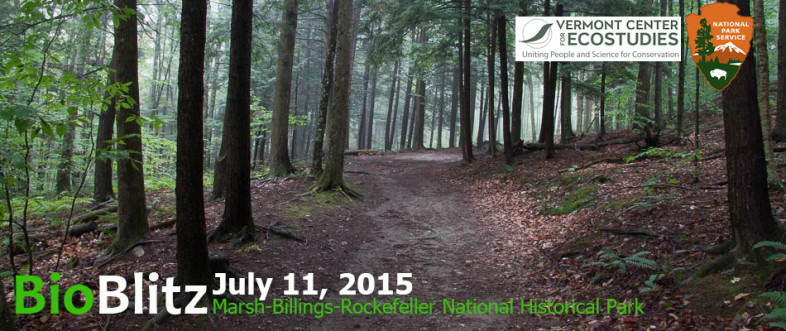
JOIN US!
Part scientific endeavor, part festival, and part education, the 2015 BioBlitz at Marsh-Billings-Rockefeller NHP (http://www.inaturalist.org/projects/mbrnhp-bioblitz-2015) will bring together leading scientists, naturalists, and community members of all ages to find and document as many species as possible in one day at the park as part of the Vermont Atlas of Life. If you plan to attend, please consider joining the MBRNHP iNaturalist BioBlitz 2015 project today!
A BioBlitz is an intensive one-day study of biodiversity in a specific location. We’ll look for birds, mammals, reptiles, butterflies, insects, spiders, trees, flowers, mushrooms, and more!
People of all ages and skill levels are welcome! Bring your smart phone if you have one. Bonus: camera, binoculars, magnifying glasses, butterfly nets, gardening gloves, and other personal equipment if you’d like. Everyone will add observations to our real-time online website on iNaturalist. We’ll be able to watch live as we find more and more species.
Festivities begin at 7am. Come at anytime. We'll be headquartered at the Forest Center building near route 12. Need more info? Call 802-457-3368 x22 for more information.
July 11 - Schedule of Events
Whether you join one of the events below or strike out on your own, there are hundreds of species of plants and animals to be discovered in the park. No experience necessary! Come to the BioBlitz headquarters at the Forest Center and learn how to use iNaturalist and check out the live species tally and map on the wall as observers like you discover the park’s biodiversity! Or watch the biodiversity tally live on our iNaturalist BioBlitz page and add your observations too!
Scheduled Events - All events start at the Forest Center (BioBlitz Headquarters)
• 7 - 9am Birds (meet at the Forest Center). The park is home to over 140 species. How many can we find in one day?
• 9 –11am Rock Walls (meet at the Forest Center). Explore old walls and help document every living thing we find among these historic walls.
• 10-12pm – Streams (meet at the Forest Center). From salamanders to water striders, the park’s waterways have a rich diversity of life. Help explore these waterways to document the biodiversity of these clear mountain streams.
• 12-1pm Lunch Bring your own lunch and join us at the Forest Center.
• 1 – 3pm Old Logs (meet at the Forest Center). Join us to discover what is hidden within and beneath old logs on the forest floor. From fungi to invertebrates or even a salamander, we’ll find and document them all.
• 1 – 4pm Mega-Transect (meet at the Forest Center). Join us as we walk across the entire park documenting everything that is found – from trees to bees and everything between. This will be a rigorous hike full of discovery.
• 2 – 4pm Pogue Pond (meet at the Forest Center). Using nets, buckets and our cameras, help document the life in the waters of this historic pond.
• 3 – 5pm Trees and Trunks (meet at the Forest Center). There’s a lot of life living on a tree. We’ll explore and photo-document all of it. From insects to lichens and more, how many species can we find living on a tree?
On-going Events at BioBlitz Headquarters at the Forest Center
• Summer Junior Ranger Adventure (ages 6-12) – Complete hands-on activities that will help you learn and explore the diversity of the Park’s habitats and creatures. Earn a Summer Junior Ranger Badge and certificate. For participating in this special adventure, you will also receive a BioBlitz Junior Ranger prize!
• iNaturalist app and web site training and help.
• See amazing insects and other critters up close as experts work to determine their identification.
Note: Schedule of events subject to change. Please check back before BioBlitz day.




